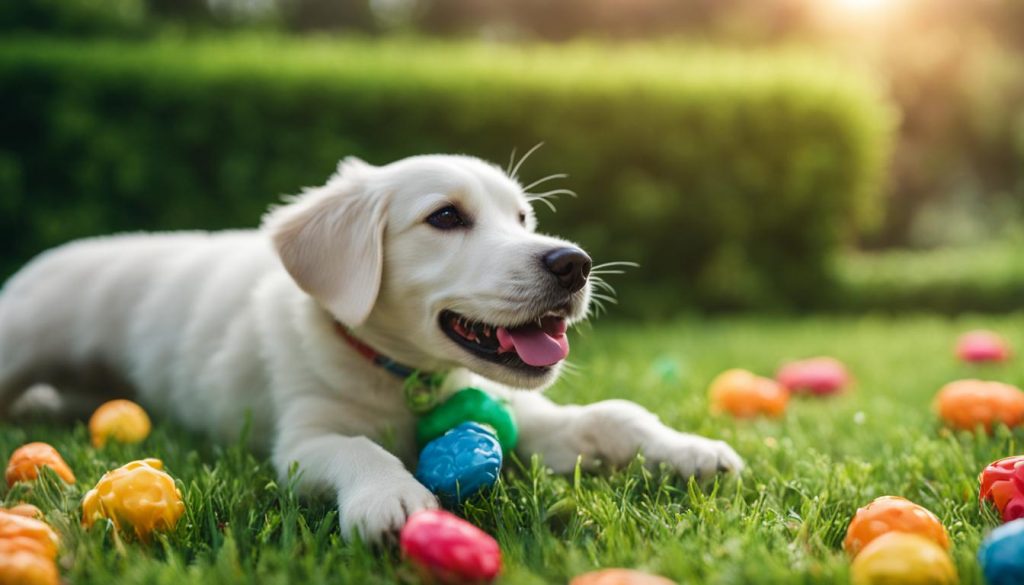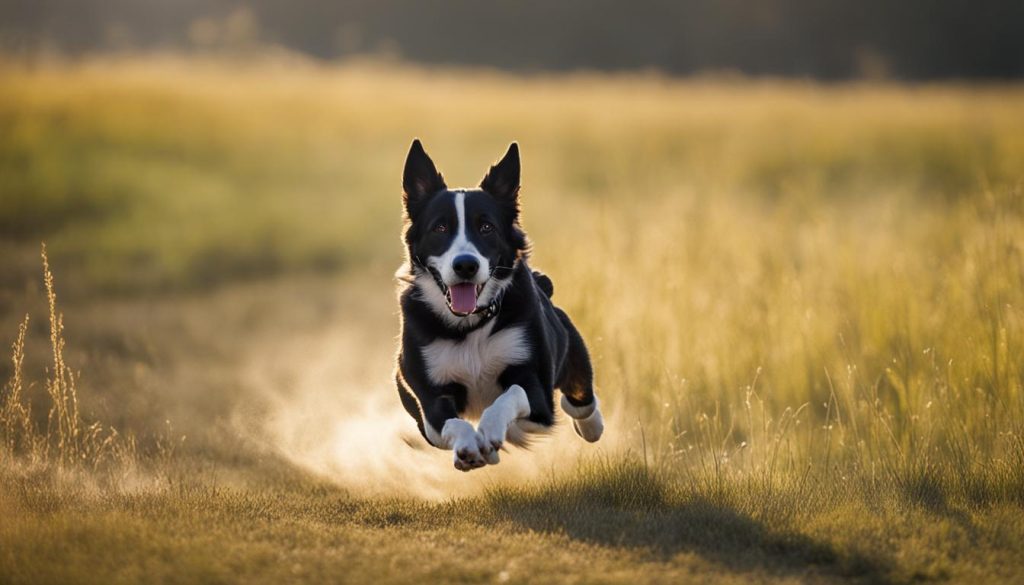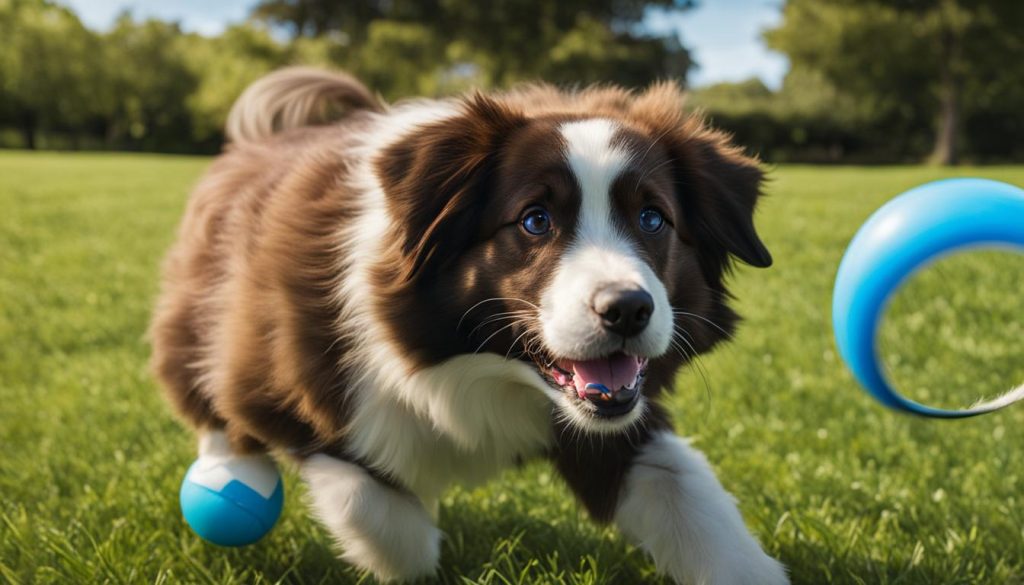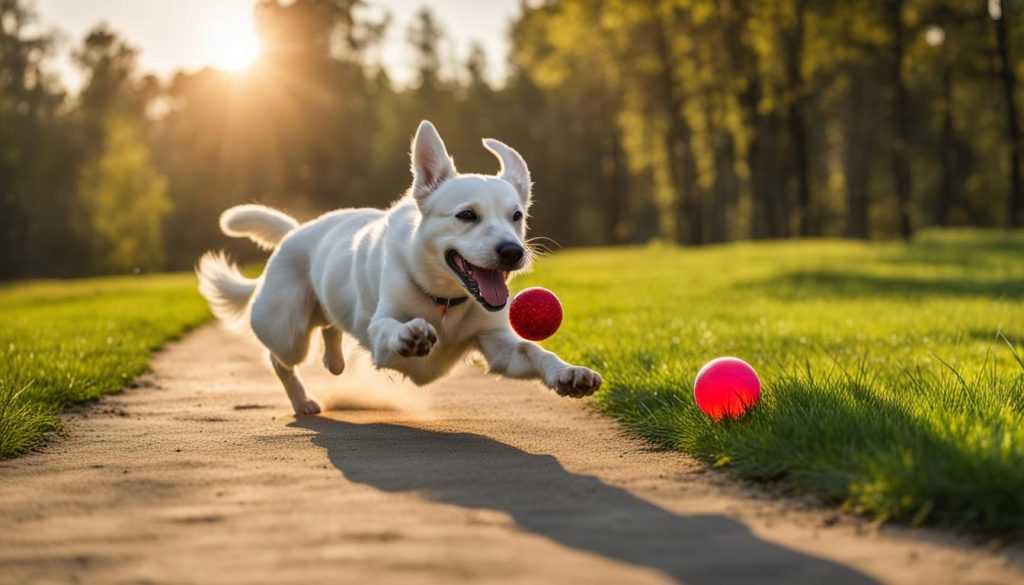Teaching a dog to retrieve a toy can be a fun and rewarding experience. By following a step-by-step guide, you can train your dog to fetch and bring back a toy. This article will provide you with all the necessary steps and tips to successfully teach your dog to get a toy.
Before you start training your dog to get a toy, make sure you have the necessary supplies, including a dog toy, training treats for dogs, and an enclosed space. Having patience and enthusiasm throughout the training process is also important for successful results.
Key Takeaways:
- Teaching your dog to retrieve a toy is a fun and rewarding experience.
- Ensure you have the necessary supplies and a safe, enclosed space for training.
- Patience and enthusiasm are crucial for successful training sessions.
- Use positive reinforcement to encourage your dog’s behavior.
- Continue training to strengthen the bond with your dog and keep them mentally stimulated.
You Will Need:
Before you start training your dog to get a toy, make sure you have the necessary supplies. Here’s a list of what you’ll need:
- Dog toy
- Training treats for dogs
- Enclosed space
- Patience
- Enthusiasm
Having these items on hand will ensure that you have everything you need to successfully train your dog to retrieve a toy. The dog toy will be the item your dog will be fetching, so choose one that is safe and appropriate for their size and breed. Training treats for dogs will serve as a reward for your dog’s successful retrieval. An enclosed space, such as a hallway or a fenced backyard, will provide a controlled environment for the training sessions. Patience and enthusiasm are crucial for keeping the training process positive and enjoyable for both you and your dog.

You Will Need: Table
| Item | Description |
|---|---|
| Dog toy | A safe and appropriate toy for your dog to retrieve |
| Training treats for dogs | Tasty treats to reward your dog’s successful retrieval |
| Enclosed space | A controlled environment for training sessions |
| Patience | Remaining calm and patient throughout the training process |
| Enthusiasm | Bringing positive energy and excitement to the training sessions |
To put it simply, the success of your dog’s training depends on the tools and mindset you bring to the table. By having the right supplies and a positive attitude, you’ll be setting yourself and your dog up for success!
Step 1: Start in Enclosed, Small Space
To teach your dog to fetch a toy, begin training in an enclosed, small space. This type of environment helps your dog stay focused and limits the places where they can take the retrieved object. Consider using a hallway or a fenced backyard for this step.
In an enclosed space, your dog is less likely to get distracted by other things and more likely to concentrate on you and the task at hand. This focused attention is crucial for teaching your dog to retrieve objects and bring them back to you.
By starting in an enclosed, small space, you create an environment that encourages your dog to stay close to you and return the toy. This sets the foundation for successful toy retrieval training.

Key points:
- Choose an enclosed, small space such as a hallway or a fenced backyard.
- An enclosed space helps your dog stay focused on you and the task at hand.
- Limiting the space encourages your dog to bring the toy back to you.
Step 2: Teach Your Dog to Chase the Toy
Now that you have created a focused and enclosed space for training, it’s time to teach your dog to chase the toy. This step is crucial in the process of teaching your dog to retrieve a toy. By encouraging your dog to chase after the toy, you are building excitement and motivating them to bring it back to you.
To begin, simply throw the toy a short distance away from you. Use an enthusiastic tone and gestures to encourage your dog to run after it. Most dogs have a natural instinct to chase after a thrown object, so you may find that your dog takes to this step quickly. Make sure to praise and reward your dog for their efforts and enthusiasm.
If your dog is not familiar with toys or does not immediately show interest in chasing the toy, take the time to introduce it to them. Play with the toy yourself, making it appear exciting and enticing. By creating a positive association with the toy, your dog will be more likely to understand the game of fetch and eagerly participate.

Expert Tip:
Start with shorter throws and gradually increase the distance as your dog becomes more comfortable and confident in chasing the toy. This will help build their stamina and endurance for longer retrieves.
Step 3: Get Your Dog to Return the Toy

Now that your dog is consistently chasing after the toy, it’s time to move on to the next step: getting them to bring it back to you. This is an essential part of the fetch command and will reinforce their understanding of the game.
To start, throw the toy a short distance and call your dog back using a positive and enthusiastic tone. Encourage them to come to you with the toy in their mouth. When they reach you, praise them and give them a reward, such as a treat or verbal praise. This positive reinforcement will reinforce the behavior and make your dog more likely to repeat it.
Repeat this process several times, gradually increasing the distance of the throw. Try to use the fetch command consistently and be patient with your dog as they learn. With time and practice, they will start to understand that bringing the toy back to you is a rewarding experience.
Benefits of Positive Reinforcement
“Positive reinforcement is an effective method for teaching your dog new behaviors. It strengthens the bond between you and your pet and creates a positive association with training. By using rewards and praise, you motivate your dog to perform the desired action willingly. This approach is gentle and encourages a positive attitude towards training.”
As you continue to practice this step, your dog will become proficient in retrieving the toy and returning it to you. This sets the foundation for more advanced tricks and commands in the future. Try to keep the training sessions fun and engaging, and always end on a positive note. With consistency and patience, your dog will become a fetching expert in no time!
Step 4: Teach Your Dog the “Drop It” Command
Now that your dog has successfully retrieved the toy and brought it back to you, it’s time to teach them the “drop it” command. This command is important as it allows you to easily take the toy from your dog’s mouth without any struggle. Patience and positive reinforcement are key when teaching this command.
To start, put your hand below your dog’s mouth and say the command “drop it” in a firm but gentle tone. You may need to wait for your dog to release the toy naturally or use a treat as a reward for letting go. Repeat this process several times, gradually reducing the use of treats until your dog responds solely to the command.
To put it simply, be patient during this process as it may take some time for your dog to fully understand and obey the command. Consistency and repetition are crucial in reinforcing the desired behavior. Reward your dog with praise and treats whenever they successfully release the toy on command.
| Step 4: Teach Your Dog the “Drop It” Command | Key Points |
|---|---|
| Teach your dog the “drop it” command by putting your hand below their mouth and saying the command. | Be patient as it may take time for your dog to understand and obey the command. |
| Use treats as a reward for letting go of the toy, gradually reducing their use over time. | Consistency and repetition are crucial in reinforcing the desired behavior. |
| Reward your dog with praise and treats when they successfully release the toy on command. | Try to be patient, consistent, and reward your dog for their progress. |

Tips for Teaching the “Drop It” Command
- Make sure to use a firm but gentle tone when giving the command.
- Be consistent with your hand placement below your dog’s mouth when teaching the command.
- If your dog is resistant to releasing the toy, try using a higher-value treat as a reward.
- Practice the “drop it” command in different environments to ensure your dog can obey in various situations.
To put it simply, patience and positive reinforcement are key when teaching your dog the “drop it” command. With time and practice, your dog will learn to release the toy on command, making playtime and training sessions more enjoyable for both of you.
Step 5: Throw the Toy Again
Now that your dog has successfully retrieved and returned the toy, it’s time to continue the fun game. By throwing the toy again, you reinforce the association between retrieving the toy and having a good time. Playtime is an essential part of the training process and helps keep your dog engaged and motivated.
To make the game more exciting, vary the distance and direction of your throws. This will challenge your dog and keep them guessing, enhancing their problem-solving skills. Try to use positive reinforcement throughout the game, praising and rewarding your dog for their efforts.
Playing fetch with your dog not only provides physical exercise but also mental stimulation. It taps into your dog’s natural instincts and gives them an outlet for their energy. Plus, it strengthens the bond between you and your furry companion as you engage in interactive play.

“Playing fetch with your dog not only provides physical exercise but also mental stimulation.”
Things to Avoid
When training your dog to get a toy, use positive reinforcement and avoid scolding. Positive reinforcement is a more effective and humane method of training, as it rewards your dog for good behavior rather than punishing them for mistakes. This approach helps build a strong bond between you and your dog, fostering trust and cooperation.
Scolding your dog during training can be counterproductive and may lead to fear and anxiety. Dogs learn best when they feel safe and motivated, so please create a positive and encouraging environment. Instead of scolding, focus on redirecting your dog’s behavior and rewarding them when they exhibit the desired actions. This will help them understand what they are doing right and encourages them to repeat the behavior.
It’s also important to consider your dog’s physical limitations during toy retrieval training. Some dogs may have physical restrictions or health conditions that affect their ability to retrieve objects. Be mindful of any limitations your dog may have and adapt the training accordingly. If necessary, consult with a veterinarian or a professional dog trainer for guidance on how to tailor the training to your dog’s unique needs.
Lastly, always play in a safe space, away from any potential dangers. Ensure that the training area is free of hazards that could harm your dog or interfere with the training process. This includes removing any small objects or obstacles that could be a choking hazard, securing any loose wires or cords, and providing a well-ventilated and comfortable environment for your dog to play in. Creating a safe space will not only protect your dog from harm but also help them feel more at ease and focused during training sessions.

Summary:
- Use positive reinforcement rather than scolding during toy retrieval training.
- Redirect your dog’s behavior and reward them for desired actions.
- Consider your dog’s physical limitations and adapt the training accordingly.
- Play in a safe space free from potential hazards.
Try These Commands Next
Once your dog has mastered retrieving a toy, you can continue their training by teaching them more advanced commands and tricks. This will help keep your dog engaged and mentally stimulated, further strengthening the bond between you and your furry friend.
One command you can consider teaching your dog is the “drop it” command. This command is useful when you want your dog to release the toy or object they have in their mouth. By using positive reinforcement and rewarding your dog when they comply with the command, they will learn to let go of the toy on cue.
Another advanced trick you can teach your dog is to retrieve multiple toys. This not only enhances their retrieving skills but also adds an element of challenge and excitement to their playtime. Start by teaching them to retrieve one toy at a time, and gradually increase the difficulty by introducing more toys for them to fetch.
Advanced Commands and Tricks
- Drop it command
- Retrieve multiple toys
- Search and find
- Hide and seek
- High five
Continuing your dog’s training with these advanced commands and tricks will provide them with mental stimulation, helping to prevent boredom and unwanted behaviors. Try to always use positive reinforcement, patience, and consistency when training your dog.
| Command | Description |
|---|---|
| Drop it | Teaches your dog to release a toy or object on command. |
| Retrieve multiple toys | Trains your dog to fetch and bring back multiple toys. |
| Search and find | Teaches your dog to search for hidden objects. |
| Hide and seek | Enables your dog to locate you or hidden items based on scent or sound cues. |
| High five | Instructs your dog to raise their paw and give a high five. |
Final Thoughts
Teaching your dog to retrieve a toy is a fun and rewarding experience that strengthens the bond between you and your pet. By following this step-by-step guide, using positive reinforcement, and being patient throughout the training process, you can successfully train your dog to fetch and bring back a toy.
To put it simply, dog training is all about consistency and repetition. By consistently reinforcing the behavior with rewards and praise, your dog will learn to associate retrieving a toy with a positive experience. The use of positive reinforcement, such as treats and enthusiastic praise, will motivate your dog to continue learning and participating in toy retrieval training.
Not only is toy retrieval training beneficial for mental stimulation and obedience, but it also provides a great opportunity for you and your dog to bond and have fun together. So, grab a toy, find an enclosed space, and start teaching your dog this exciting new skill. Enjoy the process, and continue training to reinforce the behavior and expand their repertoire of tricks and commands. Happy training!
FAQ
What supplies do I need to teach my dog to get a toy?
You will need a dog toy, training treats for dogs, and an enclosed space.
Where should I start training my dog to get a toy?
Begin the training process in an enclosed, small space like a hallway or fenced backyard.
How do I teach my dog to chase the toy?
Simply throw the toy a short distance and encourage your dog to chase after it.
What should I do when my dog brings the toy back?
Break down the fetch command into three parts: throw the toy, call your dog back using a positive tone, and reward them when they bring the toy back to you.
How do I teach my dog to drop the toy?
Put your hand below their mouth, say the “drop it” command, and reward them when they release the toy without a struggle.
How long should I play the game of fetching with my dog?
Allot at least five to ten minutes of consistent playtime to reinforce the association between retrieving the toy and having fun.
What should I avoid when training my dog to get a toy?
Use positive reinforcement instead of scolding, be aware of your dog’s physical limitations, and play in a safe space.
What commands can I try teaching my dog after they learn to get a toy?
You can teach them more advanced commands and tricks such as dropping the toy in a specific spot or retrieving multiple toys.






